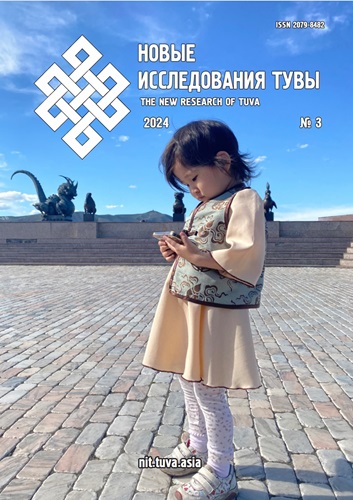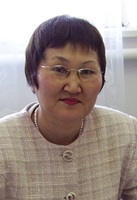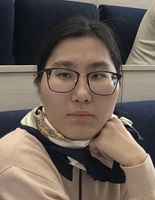The yasn ‘clan’ concept in the Kalmyk language
DOI:
https://doi.org/10.25178/nit.2024.3.18Keywords:
concept of culture; component of concept; yasn; kinship; terminology of kinship; Kalmyks; Kalmyk languageAbstract
The article presents an analysis of the concept of the Kalmyk culture “yasn” ‘clan’. It shows that the ideas of kinship have various means of designation in Kalmyk language. The nominative field of this concept includes the following lexemes: “ang”, “aamg”, “yasn”, “otg”, and “arvn”.
The conceptual content of “yasn”: ‘people of the same origin’, ‘one bone’, ‘one blood’. The family can be interrupted by the children of a daughter, or due to a curse. The son is the heir of the family.
The figurative component of this concept is understood through a person. Well-born people and those with a good pedigree are distinguished from rootless people. The axiological component of a culture defines the norms of behavior and communication within and outside the family, ensuring the continuation of cultural and social traditions. Supporting members of one's own group is an important aspect of Kalmyk behavior. For the Kalmyks, members of their own group are associated with kinship, while others are considered strangers.
References
Avliaev, G. O. (2002) The origin of the Kalmyk people. Elista, Kalmyk Book Publishing House. 326 p. (In Russ.).
Alefirenko, N. F. (2016) Linguoculturology: the value-semantic space of language. Moscow, Flinta. 288 p. (In Russ.).
Arutiunova, N. D. (1999) Language and the human world. Moscow, Yazyki russkoi kul'tury. 986 p. (In Russ.).
Badmaev, B. B. (2017) The Mongolian system of kinship terms: “seven generations of the father”. Filologicheskie nauki. Voprosy teorii i praktiki, no. 8 (74): in 2 parts; part 2, pp. 72–75. (In Russ.).
Bakaeva, E. P. (2009) Sacred codes of the Kalmyks culture. Elista, IKIAT. 159 p. (In Russ.).
Baldaev, S. P. (1961) Materials for the study of tribal and tribal relations among the Buryats. In: Baldaev, S. P. Selected works. Ulan-Ude, Buryat Book of publishing. 362 p. Pp. 77–109. (In Russ.).
Batyrov, V. V. (2016) Essays on the history of the traditional culture of the Kalmyks of the second half of the XIX century. Elista, KIGI RAN. 226 p. (In Russ.).
Vezhbitskaia, A. (2011) Semantic universals and basic concepts. Moscow, Yazyki slavianskikh kul'tur. 568 p. (In Russ.).
Vorob'ev, V. V. (2006) Linguoculturology. Moscow, RUDN. 330 p. (In Russ.).
Dushan, U. D. (1976) Customs and rituals of pre-revolutionary Kalmykia. In: Ethnographic collection. Issue 1 / ed. by N. Sh. Tashninov. Elista, Kalmyk Book Publishing House. 171 p. Pp. 5–89. (In Russ.).
Esenova, T. S. (2023) Concept of Wealth (Bain) in Kalmyk Discourse: Analyzing Lexicographical and Folklore Materials. Mongolian Studies, vol. 15, no. 3, pp. 458–469. (In Russ.). DOI: https://doi.org/10.22162/2500-1523-2023-3-458-469
Kalykova, E. A. (2010) Rod. In: Ethnocultural concepts in the minds of modern Russians. Ed. by T. S. Esenova. Elista, Kalmyk University Press. 189 p. Pp. 137–144. (In Russ.).
Karasik, V. I. (2007) Language keys. Volgograd, Paradigma. 520 p. (In Russ.).
Korsunkiev, Ts. K. (1977) On the terms of kinship among the Kalmyks. In: Culture and way of life of the Kalmyks: ethnographic studies / ed. by A. G. Mitirov. Elista, KNIIIaLI. 123 p. Pp. 59–72. (In Russ.).
Lamazhaa, Ch. K. (2023) Concepts of Culture: Form, idea, social regulation. New Research of Tuva, no. 1, pp. 6–25. (In Russ.). DOI: https://doi.org/10.25178/nit.2023.1.1
Likhachev, D. S. (1993) The conceptual sphere of the Russian language. Izvestiia RAN. Seriia literatury i iazyka, vol. 52, no. 1, pp. 3–9. (In Russ.).
Mitirov, A. G. (1998) Oirats-Kalmyks: centuries and generations. Elista, Kalmyk Book Publishing House. 384 p. (In Russ.).
Omakaeva, E. U. and Burykin, A. A. (1999) The system of kinship terms and properties among the Kalmyks. In: Algebra rodstva. Issue 4 / ed. by V. A. Popov. St. Petersburg, Kunstkamera. 288 p. Pp. 212–221. (In Russ.).
Omakaeva, E. U. and Burykin, A. A. (2001) Terms of kinship between Mongols and Buryats. In: Algebra rodstva. Issue 7 / ed. by V. A. Popov. St. Petersburg, Kunstkamera. 288 p. Pp. 240–247. (In Russ.).
Omakaeva, E. U. and Burykin, A. A. (2007) The system of kinship terms and properties of the Kalmyks (in comparison with the systems of kinship terms of the Mongols and Buryats). Mongolovedenie, no. 4, pp. 41–58. (In Russ.).
Ochir, A. (2016) Mongolian ethnonyms: questions of the origin and ethnic composition of the Mongolian peoples. Elista, KIGI RAN. 304 p. (In Russ.).
Popov, V. A. and Burykin, A. A. (2019) Kalmyk kinship terminology as a reflection of historical ties and ethnocultural contacts between the Oirat world and Tuvans. New Research of Tuva, no. 4, pp. 4–17. (In Russ.). DOI: https://doi.org/10.25178/nit.2019.4.1
Popova, Z. D. and Sternin, I. A. (2010) Cognitive Linguistics. Moscow, ACT; Vostok-Zapad. 314 p. (In Russ.).
Sarangaeva, Zh. N. (2017) Symbolic understanding of Kinship in Kalmyk, Russian and British Artistic discourse. Gumanitarnye issledovaniia, no. 4 (17), pp. 90–95. (In Russ.).
Soronzon, D. (2023) Reconstruction of the primary structures and meanings of kinship terms in the Mongolian language. Simvol nauki, no. 1–5, pp. 116–120. (In Russ.).
Stepanov, Yu. S. (2004) Constants. Dictionary of Russian Culture. Moscow, Akademicheskii proekt. 3nd ed. 992 p. (In Russ.).
Stepanov, Yu. S. (2007) Concepts. The thin film of civilization. Moscow, Yazyki slavianskoi kul'tury. 246 p. (In Russ.).
Teliia, V. N. (1996) Russian phraseology. Semantic, pragmatic and linguocultural aspects. Moscow, Yazyki russkoi kul'tury. 284 p. (In Russ.).
Tokarev, G. V. (2009) Linguoculturology. Tula, Publishing house of the Tula State Pedagogical Institute. L. N. Tolstoy University. 135 p. (In Russ.).
Tuvans. Native people (2022) / Ch. K. Lamazhaa, N. D. Suvandii, Sh. Iu. Kuzhuget, and Sh. B. Mainy; ed. by Ch. K. Lamazhaa and N. D. Suvandii. St. Petersburg, Nestor-Istoriia. 344 p. (In Russ.).
Sharaeva, T. I. (2003) On the problem of studying markers of the genus: symbolism and functions of “olgts”. Mongolovedenie, no. 2, pp. 265–272. (In Russ.).
Sharaeva, T. I. (2017) Ethnic markers of the Kalmyks: research and materials. Elista, KalmNTs RAN. 288 p. (In Russ.).
Shorkovits, D. (2004) The structure, principles and terms of the kinship system among the Kalmyks (XVII–XIX centuries). In: “Dzhangar” and the problems of epic creativity / ed. by N. Ts. Bitkeev. Elista, Dzhangar. 602 p. Pp. 446–463. (In Russ.).
Erdniev, U. E. (1974) Problems of Kalmyk ethnonymy (On the origin of some “ethnonyms”). In: Vestnik instituta, no. 10, Ethnography series / ed. by G. O. Avliaev. Elista, KNIIIaLI. 199 p. Pp. 24–36. (In Russ.).
Erdniev, U. E. (1985) Kalmyks. Elista, Kalmyk Book Publishing House. 282 p. (In Russ.).
Published
How to Cite
For citation:
Esenova T. S. and Esenova G. B. The yasn ‘clan’ concept in the Kalmyk language. New Research of Tuva, 2024, no. 3, pp. 302-313 (In Russ.). DOI: https://doi.org/10.25178/nit.2024.3.18
Issue
Section

This work is licensed under a Creative Commons Attribution-NonCommercial 4.0 International License.

Author(s) license holder(s) grant rights for their work to the journal (grantee of a license) under the simple non-exclusive open license in accordance with Art. 1286.1 «Open license for a research work, work of literature or fine arts», Civil Code of the Russian Federation.
New Research of Tuva publishes articles under the Creative Commons Attribution-NonCommercial license (CC BY-NC).
Since it is an open license, author(s) reserve the right to upload the article to their institutional repository, submit it to another journal (if it allows republications), or republish it on their own website (in full, or in part).
However, several conditions apply here:
a) The republished version must always contain the name(s) and affiliation(s) of the author(s), the original title and the hyperlink to the original version on the New Research of Tuva website;
b) It must be in open access, free of charge, and no category of readers must be in any way whatsoever advantaged over general readership.
c) should the contribution be submitted elsewhere by its author(s) without substantial modification (30% or more of original text unchanged), the body of the article should contain a disclaimer that the original version was published in New Research of Tuva (with a link to the respective page)
The CC-BY-NC is a non-revocable license which applies worldwide and lasts for the duration of the work’s copyright.










